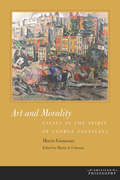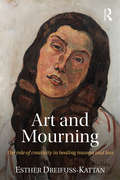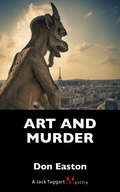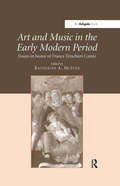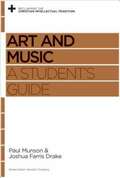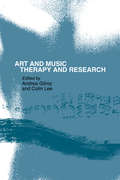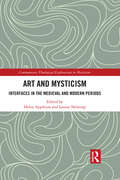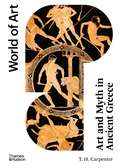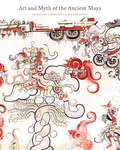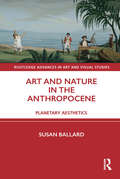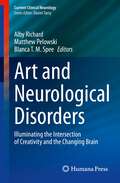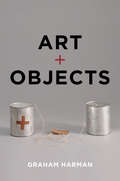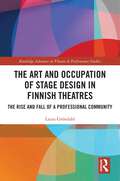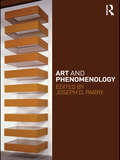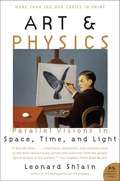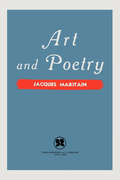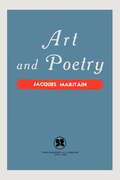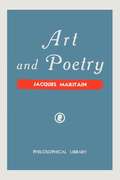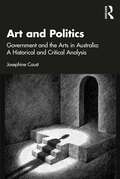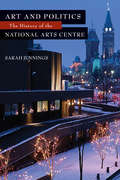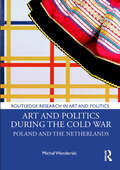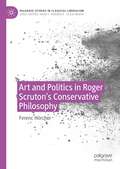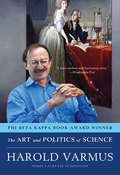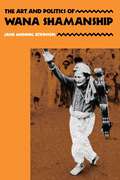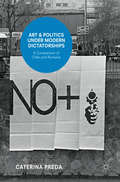- Table View
- List View
Art and Morality: Essays in the Spirit of George Santayana (American Philosophy)
by Morris Grossman Martin A. ColemanThe guiding theme of these essays by aesthetician, musician, and Santayana scholar Morris Grossman is the importance of preserving the tension between what can be unified and what is disorganized, random, and miscellaneous. Grossman described this as the tension between art and morality: Art arrests a sense of change and yields moments of unguarded enjoyment and peace; but soon, shifting circumstances compel evaluation, decision, and action. According to Grossman, the best art preserves the tension between the aesthetic consummation of experience and the press of morality understood as the business of navigating conflicts, making choices, and meeting needs.This concern was intimately related to his reading of George Santayana. The best philosophy, like the best art, preserves the tension between what can be ordered and what resists assimilation, and Grossman read Santayana as exemplifying this virtue in his embrace of multiple perspectives. Other scholars have noted the multiplicity or irony in Santayana’s work, but Grossman was unique in taking such a style to be a substantive part of Santayana’s philosophizing.
Art and Mourning: The role of creativity in healing trauma and loss
by Esther Dreifuss-KattanArt and Mourning explores the relationship between creativity and the work of self-mourning in the lives of 20th century artists and thinkers. The role of artistic and creative endeavours is well-known within psychoanalytic circles in helping to heal in the face of personal loss, trauma, and mourning. In this book, Esther Dreifuss-Kattan, a psychoanalyst, art therapist and artist - analyses the work of major modernist and contemporary artists and thinkers through a psychoanalytic lens. In coming to terms with their own mortality, figures like Albert Einstein, Louise Bourgeois, Paul Klee, Eva Hesse and others were able to access previously unknown reserves of creative energy in their late works, as well as a new healing experience of time outside of the continuous temporality of everyday life. Dreifuss-Kattan explores what we can learn about using the creative process to face and work through traumatic and painful experiences of loss. Art and Mourning will inspire psychoanalysts and psychotherapists to understand the power of artistic expression in transforming loss and traumas into perseverance, survival and gain. Art and Mourning offers a new perspective on trauma and will appeal to psychoanalysts and psychotherapists, psychologists, clinical social workers and mental health workers, as well as artists and art historians.
Art and Murder: A Jack Taggart Mystery
by Don EastonSeeking justice for the murder of a fellow cop, Jack Taggart goes undercover to penetrate a gang whose leader is the culprit. Jack Taggart is out for justice, and just a little revenge, when he goes undercover as a pimp to hunt down the murderer of a cop to whom he owes an everlasting debt of gratitude. Embroiled in a mysterious international crime syndicate, for once Taggart might be in over his head. It seemed like a simple investigation of a drug trafficker at first, but when Taggart gets a desperate call for help from one of his informants, he falls headlong into a ruthless network of black marketeering and murder orchestrated by an elusive mastermind. After an Interpol agent is compromised and assassinated, Jack is drawn deeper into the web of crime as things get personal. Despite the constant risk of exposure, Jack is getting close, but any mistake could be fatal. As his allies fall, the only protection Jack has left is a stolen painting that might as well be a bullseye on his back.
Art and Music in the Early Modern Period: Essays in Honor of Franca Trinchieri Camiz
by Katherine A. McIverThe relationship between music and painting in the Early Modern period is the focus of this collection of essays by an international group of distinguished art historians and musicologists. Each writer takes a multidisciplinary approach as he or she explores the interface between music performance and painting, or between music and art theory. The essays reflect a variety and range of approaches and offer methodologies which might usefully be employed in future research in this field. The volume is dedicated to the memory of Franca Trinchieri Camiz, an art historian who worked extensively on topics related to art and music, and who participated in some of the conference panels from which many of these essays originate. Three of Professor Camiz's own essays are included in the final section of this volume, together with a bibliography of her writings in this field. They are preceded by two thematic groups of essays covering aspects of musical imagery in portraits, issues in iconography and theory, and the relationship between music and art in religious imagery.
Art and Music: A Student’s Guide
by Paul Munson Joshua Farris DrakeGod made us to enjoy beauty wherever we find it, whether it’s music or the visual arts. But sin finds ways to obscure what is right in front of our eyes and ears. Drawing on years of teaching experience, two professors offer tips for understanding, evaluating, and appreciating art in all its forms while highlighting the important ways in which art and music reflect the glory of God. This book will help you better understand and appreciate humanity’s pursuit and imitation of beauty through artistic expression―a vital means by which we bear witness to the beauty of our Creator.
Art and Music: Therapy and Research
by Andrea Gilroy Colin LeeThis is the first comprehensive overview of the present state of research in art therapy and music therapy in the UK. It challenges assumptions about research in these areas, and makes use of research models from art history and music analysis as well as the more orthodox psychological and medical models used in clinical work. Informative and reassuring for those interested in undertaking research, the book gives lively accounts of the personal process of the art therapy and music therapy researcher. It presents the reader with many original ideas and strategies, and will be an invaluable reference book for practitioners and students of art therapy and music therapy, as well as for health professionals who work with them.
Art and Mysticism: Interfaces in the Medieval and Modern Periods (Contemporary Theological Explorations in Mysticism)
by Helen Appleton Louise NelstropFrom the visual and textual art of Anglo-Saxon England onwards, images held a surprising power in the Western Christian tradition. Not only did these artistic representations provide images through which to find God, they also held mystical potential, and likewise mystical writing, from the early medieval period onwards, is also filled with images of God that likewise refracts and reflects His glory. This collection of essays introduces the currents of thought and practice that underpin this artistic engagement with Western Christian mysticism, and explores the continued link between art and theology. The book features contributions from an international panel of leading academics, and is divided into four sections. The first section offers theoretical and philosophical considerations of mystical aesthetics and the interplay between mysticism and art. The final three sections investigate this interplay between the arts and mysticism from three key vantage points. The purpose of the volume is to explore this rarely considered yet crucial interface between art and mysticism. It is therefore an important and illuminating collection of scholarship that will appeal to scholars of theology and Christian mysticism as much as those who study literature, the arts and art history.
Art and Myth in Ancient Greece: Second Edition (World of Art #0)
by Thomas H. CarpenterAn essential visual handbook for anyone interested in Greek myth written by T. H. Carpenter, one of the world’s leading experts on myth in ancient art. The ancient Greeks recorded their mythology on vase paintings, engraved gems, and bronze and stone sculptures, offering depictions that often predate any references to the myths in literature or recount alternative, unfamiliar versions of these tales. In some cases, visual art provides our only evidence of these myths, as there are no surviving accounts in ancient Greek literature of stories such as the Fall of Troy or Theseus and the Minotaur. Art and Myth in Ancient Greece is a comprehensive survey of myth as it appears in Greek art. This classic volume has been updated with text and full-color images of more than three hundred scenes from Greek sculptures, vases, and gems. Aiding in the identification of mythological scenes and explaining chronological developments in style and subject matter, this book is an essential reference for anyone interested in the art, drama, poetry, or religion of ancient Greece.
Art and Myth of the Ancient Maya
by Oswaldo Chinchilla MazariegosThis nuanced account explores Maya mythology through the lens of art, text, and culture. It offers an important reexamination of the mid-16th-century Popol Vuh, long considered an authoritative text, which is better understood as one among many crucial sources for the interpretation of ancient Maya art and myth. Using materials gathered across Mesoamerica, Oswaldo Chinchilla Mazariegos bridges the gap between written texts and artistic representations, identifying key mythical subjects and uncovering their variations in narratives and visual depictions. Central characters—including a secluded young goddess, a malevolent grandmother, a dead father, and the young gods who became the sun and the moon—are identified in pottery, sculpture, mural painting, and hieroglyphic inscriptions. Highlighting such previously overlooked topics as sexuality and generational struggles, this beautifully illustrated book paves the way for a new understanding of Maya myths and their lavish expression in ancient art.
Art and Nature in the Anthropocene: Planetary Aesthetics (Routledge Advances in Art and Visual Studies)
by Susan BallardThis book examines how contemporary artists have engaged with histories of nature, geology, and extinction within the context of the changing planet. Susan Ballard describes how artists challenge the categories of animal, mineral, and vegetable—turning to a multispecies order of relations that opens up a new vision of what it means to live within the Anthropocene. Considering the work of a broad range of artists including Francisco de Goya, J. M. W. Turner, Robert Smithson, Nancy Holt, Yhonnie Scarce, Joyce Campbell, Lisa Reihana, Katie Paterson, Taryn Simon, Susan Norrie, Moon Kyungwon and Jeon Joonho, Ken + Julia Yonetani, David Haines and Joyce Hinterding, Angela Tiatia, and Hito Steyerl and with a particular focus on artists from Australia and Aotearoa New Zealand, this book reveals the emergence of a planetary aesthetics that challenges fixed concepts of nature in the Anthropocene. The book will be of interest to scholars working in art history, visual culture, narrative nonfiction, digital and media art, and the environmental humanities.
Art and Neurological Disorders: Illuminating the Intersection of Creativity and the Changing Brain (Current Clinical Neurology)
by Alby Richard Matthew Pelowski Blanca T. M. SpeeThere is significant academic interest in the field of art and neurological disorders. Considering how artistic expression may be modified by alterations in neural circuits, as well as in our bodies and everyday lives, associated with a range of disorders and diseases is a rich territory from which to understand the workings of our brains, the unique blend of factors leading to human art making, and disease itself. This book will be an exposé of how different neurological disorders may influence and/or relate to the artistic process, with a particular focus on visual art and painting. The book will interrogate the question of different aspects of neurological disorders and associated brain changes that may impact artistic expression (and vice versa) and will include devoted chapters on Parkinson’s disease, Epilepsy, Mood Disorders, Autism, and Schizophrenia. Moreover, we will elaborate on the question from the perspective of the artist themselves, with chapters that highlight the artistic process in the context of lived experience (either directly or indirectly) with disease-mediated brain changes. Finally, engagement in creative acts has been linked to therapeutic benefits in multiple disease processes and neuroplasticity, which is another line of inquiry directly addressed in the book. As a whole, the volume focuses on themes and concepts at the boundary of creativity and neuroscience in such a way as to be relevant to both the medical and broader (artistic) community.
Art and Objects
by Graham HarmanIn this book, the founder of object-oriented ontology develops his view that aesthetics is the central discipline of philosophy. Whereas science must attempt to grasp an object in terms of its observable qualities, philosophy and art cannot proceed in this way because they don't have direct access to their objects. Hence philosophy shares the same fate as art in being compelled to communicate indirectly, allusively, or elliptically, rather than in the clear propositional terms that are often taken – wrongly – to be the sole stuff of genuine philosophy. Conceiving of philosophy and art in this way allows us to reread key debates in aesthetic theory and to view art history in a different way. The formalist criticism of Greenberg and Fried is rejected for its refusal to embrace the innate theatricality and deep multiplicity of every artwork. This has consequences for art criticism, making pictorial content more important than formalism thinks but less entwined with the social sphere than anti-formalism holds. It has consequences for art history too, as the surrealists, David, and Poussin, among others, gain in importance. The close link between aesthetics and ontology also invites a new periodization of modern philosophy as a whole, and the habitual turn away from Kant’s thing-in-itself towards an increase in philosophical "immanence" is shown to be a false dawn. This major work will be of great interest to students and scholars of philosophy, aesthetics, art history and cultural theory.
The Art and Occupation of Stage Design in Finnish Theatres: The Rise and Fall of a Professional Community (ISSN)
by Laura GröndahlThis study explores the formation, establishment, expansion, and disintegration of stage design as a modern profession and a recognized artform in Finnish theatres.Drawing on oral or written recollections and thoughts of stage designers from different decades, the author asks how their artistic agencies, occupational identities, and theoretical self-understanding have been constituted. She analyses Finnish theatre history from new perspectives by shifting the focus from finished performances to largely unknown practices behind the scenes. This book examines the cultural institutions that have constituted the stage designers’ role and position, like the professional city theatre system, the craft union, and education. This research shows how modern and postmodern scenographic innovations have been assimilated to local contexts, and how material and cultural circumstances have reshaped the artistic practices. Without bypassing canonical trendsetters or hegemonic cultural mindsets, the focus is directed on the everyday grassroot level of stage design practices. Personal interviews with over 20 designers make visible an ample repertoire of unwritten knowledge stored in habitual ways of working and dealing creatively with the complex system of theatre making.This book will be of great interest to students and scholars in theatre and performance studies with a focus on scenography.
Art and Phenomenology
by Joseph D. ParryPhilosophy of art is traditionally concerned with the definition, appreciation and value of art. Through a close examination of art from recent centuries, Art and Phenomenology is one of the first books to explore visual art as a mode of experiencing the world itself, showing how in the words of Merleau-Ponty ‘Painting does not imitate the world, but is a world of its own’. An outstanding series of chapters by an international group of contributors examine the following questions: Paul Klee and the body in art colour and background in Merleau-Ponty’s phenomenology of art self-consciousness and seventeenth-century painting Vermeer and Heidegger philosophy and the painting of Rothko embodiment in Renaissance art sculpture, dance and phenomenology. Art and Phenomenology is essential reading for anyone interested in phenomenology, aesthetics, and visual culture.
Art and Physics: Parallel Visions in Space, Time, and Light
by Leonard ShlainIn this book, Leonard Shlain explores how artistic breakthroughs could have prefigured the visionary insights of physicists on so many occasions throughout history. Art & Physics is a seamless integration of the romance of art and the drama of science--and an exhilarating history of ideas.
Art and Poetry
by Jacques MaritainOriginally titled Frontières de la Poésie (1935), this book by Jacques Maritain, whose philosophical writings read as interestingly as a novel, will be welcomed by all who are seeking a better understanding of the art of our time. The book delves into Maritain's thoughts on the nature and subjectivity of art and poetry. As a philosopher, Maritain attempts to define the two concepts, describing art and poetry as virtues, and as being primarily concerned with beauty. Rather than focus on aesthetic theory, Maritain examines the concepts at a more tangible level, including a discussion of how they are made. The principles established with such precision and brilliance in his earlier work, Art and Scholasticism, which has had such a deep influence on contemporary artists, are successfully put to the test in illuminating the creative works of such diverse artists as Georges Rouault, Marc Chagall, Gino Sevirini, and Arthur Lourie.
Art and Poetry
by Jacques MaritainThe French philosopher&’s treatise on the nature of art and poetry includes enlightening critiques of major painters and dialogues with notable writers.Originally published in 1935 with the title Frontières de la Poésie, this work by Jacques Maritain explores the nature and subjectivity of art and poetry. As a philosopher, Maritain attempts to define the two concepts, describing them as virtuous, being primarily concerned with beauty. Rather than focusing on aesthetic theory, Maritain examines his ideas at a more tangible level, including a discussion of how art and poetry are produced.Art and Poetry further develops the principles established in Maritain&’s earlier work, Art and Scholasticism, which has deeply influenced contemporary artists. Those concepts are employed here to illuminate the creative works of such diverse artists as Georges Rouault, Marc Chagall, Gino Severini, and Arthur Lourié. Maritain also relates fascinating dialogues with notable authors such as André Gide, Jean Cocteau, and others.
Art and Poetry
by Jacques MaritainOriginally titled Frontieres de la poesie (1935), This book by Jacques Maritain, whose philosophical writings read as interestingly as a novel, will be welcomed by all who are seeking a better understanding of the art of our time. The book delves into Maritain s thoughts on the nature and subjectivity of art and poetry. As a philosopher, Maritain attempts to define the two concepts, describing art and poetry as virtues, and as primarily concerned with beauty. Rather than focus on aesthetic theory, Maritain examines the concepts at a more tangible level, including a discussion of how they are made. The principles established with such precision and brilliance in his earlier work Art and Scholasticism, which has had such a deep influence on contemporary artists, are successfully put to the test in illuminating the creative works of such diverse artists as Rouault, Marc Chagall, Gino Sevirini, and Arthur Lourie. Jacques Maritain was a French Catholic philosopher and political thinker. He was born in Paris in 1882, where he spent most of his life. His father was a prominent lawyer and his mother the daughter of a statesman. He attended the Sorbonne to study philosophy and natural science, and after marrying, he and his wife converted to Catholicism. It was after this he became a well-known scholar of St. Thomas Aquinas and Thomistic philosophy. He published widely on philosophical and political thought, and by the 1930s, he was an established thinker in the Catholic community. After the outbreak of WWII, Maritain relocated to the United States, where he taught at Princeton University and Columbia University. Later in life, he and his wife returned to France, where he continued to write and study Catholic scholarship until his death in 1973.
Art and Politics: Government and the Arts in Australia: A Historical and Critical Analysis
by Josephine CaustAustralian governments at all levels have been engaged with arts and culture in many different forms since the beginning of European settlement. The way this has occurred is documented and analysed here, both from an historical and critical perspective. Changing understandings of culture and the significance of Indigenous Culture to Australia receive special attention. While the focus is primarily directed to Federal Government engagement, there is also consideration paid to both state and local government involvement. There is attention paid to the censorship of arts practice by governments as well as the direct interventions by politicians in arts practice. Different approaches to the arts by governments are also considered, as well as attempts to develop a national cultural policy. The impact of the recent pandemic is addressed and various research reports about the arts sector and its relationship with government are also noted. There is then a final discussion about some issues that governments could address in the future, that might ensure a more sustainable Australian arts sector. This book will be of particular interest to scholars of contemporary arts, arts management, cultural history, public policy and cultural policy. It may also interest bureaucrats and politicians.
Art and Politics: The History of the National Arts Centre
by Sarah JenningsShort-listed for the Ottawa Book Awards, 2010 This is the story of the creation and first four decades of one of Canada’s pre-eminent cultural organizations. While it documents the history of Canada’s National Arts Centre in Ottawa, it also tells the story of the arts in Canada from the 1960s to 2006. The story breaks down into three parts: the years of creation and early growth, fuelled by the talent and resources generated by Canada’s 1967 Centennial celebration; the turbulent middle years, marked by a dearth of funds and political disinterest; and finally the "renaissance," when the decision is made to restore and recast the organization to provide continuing benefit to the performing arts in Canada’s capital and the country at large. Written in a documentary style, moving from episode to episode, the story is enriched by the personal memories of those who participated in it, including the leading artists, managers, officials, and politicians who were involved.
Art and Politics During the Cold War: Poland and the Netherlands (Routledge Research in Art and Politics)
by Michał WenderskiDrawing on thousands of historical documents from Polish and Dutch archives, this book explores Cold War cultural exchange between so-called ‘smaller powers’ of this global conflict, which thus far has been predominately explored from the perspective of the two superpowers or more pivotal countries. By looking at how cultural, artistic and scholarly relations were developed between Poland and the Netherlands, Michał Wenderski sheds new light on the history of the Cultural Cold War that was not always orchestrated solely by its main players. Less pivotal states – for example, Poland and the Netherlands – likewise intentionally created their international cultural policies and shaped their cultural exchange with countries from the other side of the Iron Curtain. This study reconstructs these policies and identifies the varying factors that influenced them – both official and less formal. The book will be of interest to scholars working in art history, history of the Cold War, post-war European history, international cultural relations, Dutch studies and Polish studies.
Art and Politics in Roger Scruton's Conservative Philosophy (Palgrave Studies in Classical Liberalism)
by Ferenc HörcherThis book covers the field of and points to the intersections between politics, art and philosophy. Its hero, the late Sir Roger Scruton had a longstanding interest in all fields, acquiring professional knowledge in both the practice and theory of politics, art and philosophy. The claim of the book is, therefore, that contrary to a superficial prejudice, it is possible to address the philosophical issues of art and politics in the same oeuvre, as the example of this Cambridge-educated analytical philosopher proves.Accordingly, the book has a bold thesis on the general, theoretical level, mapping the connections between politics, art and philosophy. However, it also has a pioneering commitment on the level of the particular, offering the first full-length study into the philosophical legacy of Roger Scruton, probably the most important British conservative philosopher of the late 20th and the first decades of the 21st century. It also allows reader to look into the philosopher’s fascination with Central European art and culture. Finally, it also provides a daring analysis of the late Scruton’s metaphysical inspirations, connecting the arts, and especially music, with religion and the bonds of love.
The Art and Politics of Science
by Harold VarmusA Nobel Prize-winning cancer biologist, leader of major scientific institutions, and scientific adviser to President Obama reflects on his remarkable career. A PhD candidate in English literature at Harvard University, Harold Varmus discovered he was drawn instead to medicine and eventually found himself at the forefront of cancer research at the University of California, San Francisco. In this "timely memoir of a remarkable career" (American Scientist), Varmus considers a life's work that thus far includes not only the groundbreaking research that won him a Nobel Prize but also six years as the director of the National Institutes of Health; his current position as the president of the Memorial Sloan-Kettering Cancer Center; and his important, continuing work as scientific adviser to President Obama. From this truly unique perspective, Varmus shares his experiences from the trenches of politicized battlegrounds ranging from budget fights to stem cell research, global health to science publishing.
The Art and Politics of Wana Shamanship
by Jane Monnig AtkinsonRituals are valued by students of culture as lenses for bringing facets of social life and meaning into focus. Jane Monnig Atkinson's carefully crafted study offers unique insight into the rich shamanic ritual tradition of the Wana, an upland population of Sulawesi, Indonesia.
Art and Politics under Modern Dictatorships: A Comparison of Chile and Romania
by Caterina PredaThis book analyzes the relationship between art and politics in two contrasting modern dictatorships. Through a detailed look at the Chilean and Romanian dictatorships, it compares the different ways in which political regimes convey their view of the world through artistic means. It examines how artists help \ convey a new understanding of politics and political action during repressive regimes that are inspired by either communism or anti-communism (neoliberalism, traditionalist, conservative). This book demonstrates how artistic renderings of life during dictatorships are similar in more than one respect, and how art can help better grasp the similarities of these regimes. It reveals how dictatorships use art to symbolically construct their power, which artists can consolidate by lending their support, or deconstruct through different forms of artistic resistance.
